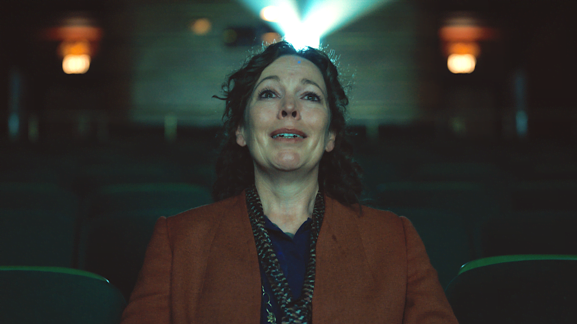
To the cinema to see a film about cinema. Is there any art form, any medium, that has been quite so sentimental about itself as cinema? There is nostalgia in the understanding of every art form or medium which has transformed through time, but cinema’s forlornness seems particular to itself. It is summed up by the shot of the viewer, face rapt in light and bright with love, seated in the centre of a row, framed by the cinema seats around them, staring up to follow the light of the projector and the invisible screen. Invisible, because what they are actually looking at is us in the audience (or a little above us), the film besotted with its audience, telling us that what we are looking at is actually a mirror. We must go to the cinema to be like this – the image is what defines it.
That clichéd moment is there, of course, in Empire of Light, the film we went to see. It’s a curious work that tries to blend the stories of two people afflicted the one by schizophrenia, the other by racism, with a love of the traditional experience of cinema. Olivia Colman plays an unhappy duty manager at a Margate cinema who never has the time to see a film, until finally she has the cinema to herself and asks to see one. The title picked, Being There (1979), is a peculiar choice, but it is there for exigences of plot. Colman, bathed in that light, tearfully stares up at that point above us and is transported.

When did this image of cinema begin? Pictures of the cinema audience are as old as cinema – starting with the image of the Cinématographe Lumière on an 1896 poster, with the audience laughing at Arroseur et arrosé. The cinema audience, whether as a mass or with focus on an individual, has remained common in advertisements, posters, postcards, photographs, and in stock image libraries. But these are the views of outsiders. It is in the films themselves that we can see how the industry wants us to see it, and from where the image of centralised figure staring up at the screen derives.
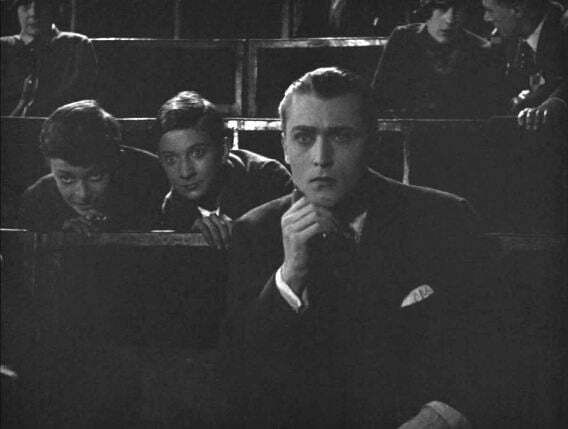
The image of the individual in the audience wholly engrossed by what thy see on the screen probably starts in the 1920s. Two 1928 films about film itself, Show People and Shooting Stars, have film actors uplifted by the sight of themselves on the screen, respectively Marion Davies and Brian Aherne. The latter, playing a failure in life who lifted by the sight of his heroic other self on the screen, is an early indicator of the viewer who in seeing the film sees inside themselves. But the film’s purpose is satire not nostalgia. Film needed to have outlived a generation or two before that could happen.
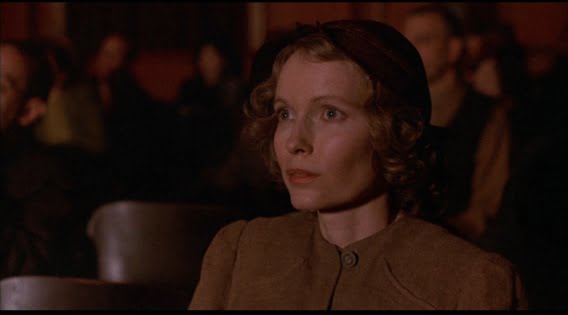

So one has to pass over films with notable audience or viewer scenes (Sabotage, Sullivan’s Travels, Brief Encounter, Bonnie and Clyde, Taxi Driver, even The Smallest Show on Earth with its rather forced sentiment about old cinemas and remote silent films) to films that look back on a cinema that is being lost, by concentrating usually on the one viewer. Maybe it begins with Victor Erice’s El espíritu de la colmena (The Spirit of the Beehive) (1973), with its 1930s Spanish child open-mouthed at the sight of Frankenstein’s monster, or Woody Allen’s The Purple Rose of Cairo (1985), with Mia Farrow as the 1930s downtrodden cinema fan, who literally escapes into the films she so loves. However, the shots of them in their respective audiences are at an angle rather than face on, hence realistic rather than symbolic. The individual cinema member viewed face-on as they are fixated on the screen is absolutely there in Cinema Paradiso (1988), where the child Salvatore Cascio becomes enraptured by what he is able to see in his small-town cinema, but the image is pure nostalgia. More needs to be added before the theme is fully in place.
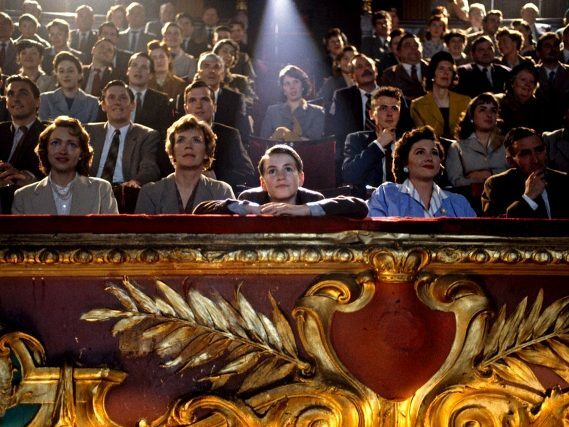
The film that may have established the image of transportation, in its framing and symbolism, is Terence Davies’ The Long Day Closes (1992). The partly-autobiographical work, set in 1950s Liverpool, focusses on how a child from a working class background, Bud (played by Leigh McCormack), escapes from the narrow confines of his life through a powerful imagination. This is exemplified in an iconic image of Bud seated at the front and centre of the circle seats in a cinema. He is surrounded by the audience but separate from it, bathed in projector light as though he were the projected image (which for we the audience is the case) while he is fixated on the unseen screen, his face awash with light and love.
The image is both nostalgic and free from time. It looks back to the particularities of the experience of cinema in 1950s Britain, but it is a reflection rather than a recreation. It is understood from our remote perspective. It says this is what we have lost but is yet not lost while we can still remember it. Specifically, by showing what the filmmaker remembers of cinema as place and experience, it enshrines what is being lost of cinema – which is why it so often used to portray classical cinemagoing. Nostalgia kills the thing it loves.

The Long Day Closes followed on from Davies’ similarly autobiographical Distant Voices, Still Lives (1992), which also celebrates what was memorable about cinema, in an image of two women family members smiling at the screen, but that from the latter film is the more acute for concentrating on the individual. It’s an image has been emulated – whether deliberately or inevitably – in films such as Amélie (2001), Hugo (2011) and La La Land (2016). The latter two feature couples caught up by the screen, which may dissipate the power of the image, but in Hugo‘s case it adds an almost didactic tone, showing children enjoying films of the past the way that they tend not to, but (the film implies) should.
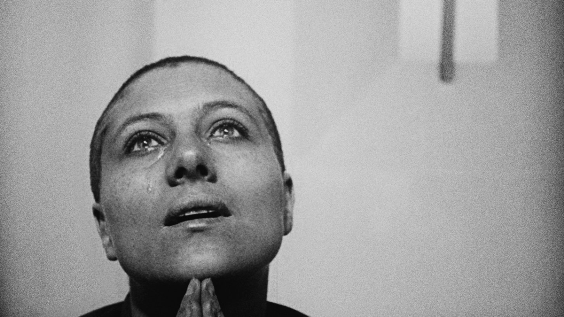

However, the rapturous quality of the image, which is so powerfully there in Empire of Light, is not necessarily to be traced through scenes from other films that show cinema audiences. Films where protagonists look up to some object above us (i.e. in film observer terms) that seems to pierce their very soul, are films where they are supposed to be having a sight, or sense, of God. Falconetti in La Passion de Jeanne d’Arc (1928), a scene from which is memorably intercut with shots of Anna Karina empathetically watching the film in a cinema in Vivre Sa Vie (1962), or Jennifer Jones in The Song of Bernadette (1943), are two examples where the characters are similarly transported, taken out of this world in their eyes and in how they are framed. They look beyond the screen to something the viewer can only sense but not see for themselves, an iconography of course taken from centuries of Christian art.

There is a difference, in that the protagonists in religious films are often looking at what cannot be seen. The vision is frequently in their minds only, whereas the cinema-goer sees what they see (hence Falconetti sees beyond us, but Anna Karina sees Falconetti). There are close parallels nonetheless. Both cinema experience and religious experience invite absolute love.
It’s all sentimental nonsense. When I saw Olivia Colman weeping over Being There, alone in a huge cinema, I couldn’t help but think that there was no real difference between the physical experience as shown and watching the film at home on television. OK, so large- flat-screen TVs weren’t around in 1981, but the film is preaching a lesson to the people of 2023, not those of four decades ago. This what you are losing it instructs us – rapture, absolute love.
Of course there can be rapture, and cinema in its traditional form has meant so much to so many. But it has also been quite ordinary. It was the routine aspect of cinema, the habit of going twice a week because that’s how often the films were changed in cinema’s heyday, that gave cinema meaning. It was convenient and belonged to the daily round. That is no longer the case. It is no longer a mass medium; instead, it is a staging post for some visual entertainments before they reach their mass audience further down the line – on phones, tablets, TV screens or whatever. Those viewers may be enraptured, or mildly entertained, depending on their point of view. The cinema has only ever been a means to an end.
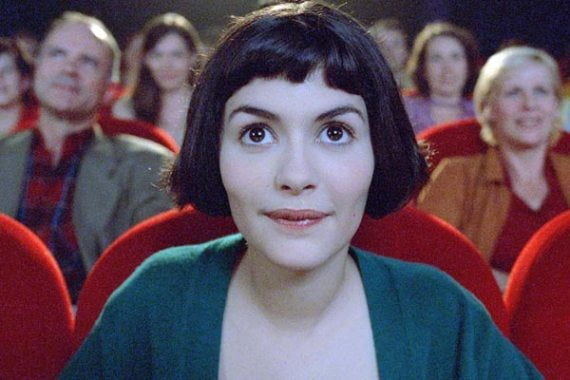
What films like Empire of Light may actually be about is a loss of power. I wrote a while ago about Martin Scorsese’s complaints that people might watch his film The Irishman (2019) on their phones rather than on the big screen where it belonged. Nothing wrong with a big screen, of course, but I decided to watch the film on my phone to see what was different. I didn’t detect much, beyond the awkwardness of watching a three-hour film on a small screen and having to wear headphones. I concluded,
… maybe there is something else that, deep down, bothers Scorsese. In cinema we look up, in thrall to the big screen, subservient in our way. Television we see on a level, medium and recipient in equal control of the other. With a phone, we look down. We are in charge. It is not the pictures that got small, it’s Scorsese.
Those raised eyes, that look of supplication, that blind faith, are past. The films are at our level, and in our hands. Those who would have us look up to the light no longer wield such power. A film like Empire of Light pleads for us to believe, but we don’t need to. Cinema makes for beautiful memories, but film has moved on, and the audience with it.
Links:
- Some of these issues are covered in an earlier blog post, The Face of Audience
- There are images of cinema audiences included in my Picturegoing blog, which documents the experience of going to the cinema (though it is not being added to a great deal at the moment)
- The BFI has a good, part-illustrated list of eighty films that feature scenes inside cinemas, from 2021. The Long Day Closes heads the piece, naturally
Fascinating post Luke, though I think you are really under-selling the Tornatore film – but then, I would think that. Certainly, my experience of Italian cinema-going in the 70s was as chaotic and with almost as much audience participation as in its 1950s depiction Does the Mia Farrow character literally escape into the film in the Allen film? I thought it was the opposite, with the fictional characters breaking out from celluloid into “reality” (in fine Pitandellian fashion)
Hi Sergio,
Thank you. There is more to Cinema Paradiso than nostalgia, of course, but it fitted the argument at that point. From what I recall (and what Wikipedia reminds me) Farrow’s character both enters the film and has Jeff Daniels come to her. It’s so long since I’ve seen it.
It was one of the blog posts that started simple then grew as I got into it. Probably I should have started it all over again once I’d got all my material, and maybe based it around Vivre Sa Vie (which I’d forgotten until I was doing some Joan of Arc searches). Some of it is rehashes of stuff I’ve done before – I laid into Hugo back in Bioscope days, https://thebioscope.net/2012/01/01/the-age-of-innocence.
I must rewatch CAIRO – a real favourite but it’s probably been 20 years since I’ve seen it (gulp). Re-watched PARADISO lady week with my nieces, who had never seen it before (and they loved it – we’d just returned from Umbria after a 6 year gap so were feeling pretty emotional admittedly).
Just watched PURPLE ROSE and it really stands up. And I had completely forgotten about her entering the film. Ah well…
Alas, I don’t have a copy and must rectify this. Why are so many of Allen’s 1980s films not currently available in the UK (on disc that is)? I did get A Midsummer Night’s Sex Comedy the other day, so can console myself with that for the time being.
Hmmm … thought provoking.
That’s the idea.